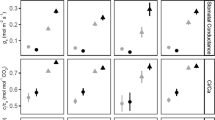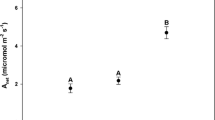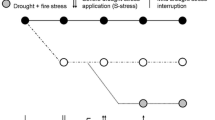Abstract
Key message
Wildtype and horticultural varieties of red maple seedlings had different morphologies and physiological responses to water stress and abundances of an insect herbivore when grown in a common garden.
Abstract
Horticultural varieties of trees (cultivars) are selected for desirable and consistent morphologies relative to wildtype trees, but the ways by which morphology influences intraspecific physiological and ecological responses are unclear. In this study, we compared morphology, gas exchange and water use efficiency, and stem herbivory for seedlings of wildtype red maple (Acer rubrum) and two cultivars, ‘Summer Red’ and ‘Brandywine,’ grown together in a common garden. Seedlings also received high and low water treatments. Overall, wildtype seedlings grew taller, had fewer, larger leaves, intermediate rates of photosynthesis, and lower abundances of the scale insect Melanapsis tenebricosa, relative to the cultivars. Summer Red seedlings had more leaves, leaves with red coloration throughout the growing season, and the highest rates of photosynthesis, although photosynthesis was higher in green relative to red leaves. Brandywine seedlings tended to be intermediate in morphology, exhibited smaller differences between the high and low water treatments, and had higher leaf water use efficiency than Summer Red seedlings in April and June but similar water use efficiency in September. Total seedling water use efficiency, measured in September, was highest for wildtype seedlings. Both cultivars had more scale insects than wildtype seedlings under well-watered conditions. These differences among types of red maple aid in understanding how intraspecific variation in tree appearance—and the en masse planting of a single cultivar in cities—affects physiological and ecological responses, the provision of ecosystem services, and the condition of planted trees.





Similar content being viewed by others
References
Abrams MD (1998) The red maple paradox. Bioscience 48:355–364. https://doi.org/10.2307/1313374
Adkins CR, Braman SK, Chappell MR, Chong J-H, Derr JF, Dunwell WC, Frank SD, Fulcher AF, Hale FA, Klingeman WE et al. (2012) IPM for select deciduous trees in southeastern US nursery production. Fulcher AF, White SA, Eds. Knoxville, TN: Southern Nursery IPM Working Group
Backe KM, Frank SD (2019) Chronology of gloomy scale (Hemiptera: Diaspididae) infestations on urban trees. Environ Entomol. https://doi.org/10.1093/ee/nvz094
Bates D, Maechler M, Bolker B, Walker (2013) lme4: linear mixed-effects models using Eigen and S4. R package version 1.0-5. http://CRAN.R-project.org/package=lme4
Bauerle WL, Dudley JB, Grimes LW (2003) Genotypic variability in photosynthesis, water use, and light absorption among red and Freeman maple cultivars in response to drought stress. J Am Soc Hort Sci 128(3):337–342
Baulmer ER, Harrist RB, Carvajal S (2003) Analysis of repeated measures data. In: Reise SP, Duan N (eds) Multilevel modeling: methodological advances, issues, and applications. Lawrence Erlbaum Associates, Publishers, Mahwah
Bodnaruk EW, Kroll CN, Yang Y, Hirabayashi S, Nowak DJ, Endreny TA (2017) Where to plant urban trees? A spatially explicit methodology to explore ecosystem service tradeoffs. Landsc Urban Plan 157:457–467. https://doi.org/10.1016/j.landurbplan.2016.08.016
Brown VK, Lawton JH (1991) Herbivory and the evolution of leaf size and shape. Proc R Soc B 333:265–272. https://doi.org/10.1098/rstb.1991.0076
Burger J, Edwards GE (1996) Photosynthetic efficiency, and photodamage by UV and visible radiation, in red versus green leaf Coleus varieties. Plant Cell Physiol 37:395–399. https://doi.org/10.1093/oxfordjournals.pcp.a028959
Coley PD, Aide MT (1989) Red coloration of tropical young leaves: a possible antifungal defence? J Trop Ecol 5:293–300. https://doi.org/10.1017/s0266467400003667
Dale AG, Frank SD (2014) The effects of urban warming on herbivore abundance and street tree condition. PLoS One 9(7):e102996. https://doi.org/10.1371/journal.pone.0102996
Dale AG, Frank SD (2017) Warming and drought combine to increase pest insect fitness on urban trees. PLoS One 12(3):e0173844. https://doi.org/10.1371/journal.pone.0173844
Dale AG, Youngsteadt EK, Frank SD (2016) Forecasting the effects of heat and pests on urban trees: impervious surface thresholds and the ‘Pace-to-Plant’ technique. Arboric Urb For 42:181–191
Ealson HM, Bloom AJ (2014) Easy leaf area: automated digital image analysis for rapid and accurate measurement of leaf area. Appl Plant Sci 2(7):1400033. https://doi.org/10.3732/apps.1400033
Fang C, Monson RK, Cowling EB (1996) Isoprene emission, photosynthesis, and growth in sweetgum (Liquidambar styraciflua) seedlings exposed to short- and long-term drying cycles. Tree Physiol 16:441–446
Frank SD, Klingeman WE, White SA, Fulcher A (2013) Biology, injury, and management of maple tree pests in nurseries and urban landscapes. J Integr Pest Manag. https://doi.org/10.1630/ipm12007
Halekoh U, Højsgaard S (2014) A Kenward-Roger approximation and parametric bootstrap methods for tests in linear mixed models: the R package pbkrtest. J Stat Soft 59:1–30. https://doi.org/10.18637/jss.v059.i09
Hovenden MJ, Vander Schoor JK (2006) The response of leaf morphology to irradiance depends on altitude of origin in Nothofagus cunninghamii. New Phytol 169:291–297. https://doi.org/10.1111/j.1469-8137.2005.01585.x
Jensen SM, Schaarschmidt F, Onofri A, Ritz C (2018) Experimental design matters for statistical analysis: how to handle blocking. Pest Manag Sci 74:523–534
Just MG, Frank SD, Dale AG (2018) Impervious surface thresholds for urban tree site selection. Urb For Urb Green 34:141–146. https://doi.org/10.1016/j.ufug.2018.06.008
Kirnbauer MC, Baetz BW, Kenney WA (2013) Estimating the stormwater attenuation benefits derived from planting four monoculture species of deciduous trees on vacant and underutilized urban land parcels. Urb For Urb Green 12:401–407. https://doi.org/10.1016/j.ufug.2013.03.003
Kjelgren R, Montague T (1998) Urban tree transpiration over turf and asphalt surfaces. Atmos Environ 32:35–41
Kuznetsova A, Brockhoff PB, Christensen RHB (2016) lmerTest: tests in linear mixed effects models. R package version 2.0–30. http://CRAN.R-project.org/package=lmerTest
Lahr EC, Dunn RR, Frank SD (2018) Variation in photosynthesis and stomatal conductance among red maple (Acer rubrum) urban planted cultivars and wildtype trees in the southeastern United States. PLoS One 13(5):e197866
Luke SG (2017) Evaluating significance in linear mixed-effects models in R. Behav Res Methods 49:1494–1502
McNeish D (2017) Small sample methods for multilevel modeling: a colloquial elucidation of REML and the Kenward-Roger correction. Multivar Behav Res 52:661–670. https://doi.org/10.1080/00273171.2017.1344538
McPherson EG, Nowack D, Heisler G, Grimmond S, Sough C, Grant R, Rowntree R (1997) Quantifying urban forest structure, function, and value: the Chicago Urban Forest Climate Project. Urban Ecosyst 1:49–61
Meineke EK, Frank SD (2018) Water availability drives tree growth responses to herbivory and warming. J Appl Ecol. https://doi.org/10.1111/1365-2664.13130
Meineke EK, Dunn RR, Sexton JO, Frank SD (2013) Urban warming drives insect pest abundance on street trees. PLoS One 8(3):e59687
Meineke EK, Youngsteadt E, Dunn RR, Frank SD (2016) Urban warming reduces aboveground carbon storage. Pro R Soc B 283:20161574. https://doi.org/10.1098/rspb.2016.1574
Menzies IJ, Youard LW, Lord JM, Carpenter KL, van Klink JW, Perry NB, Schaefer HM, Gould KS (2016) Leaf color polymorphisms: a balance between plant defence and photosynthesis. J Ecol 104:104–113. https://doi.org/10.1111/1365-2745.12494
Metcalf ZP (1912) The gloomy scale, an important enemy of shade trees in North Carolina. J Elisha Mitchell Sci Soc 28:88–91
Nowak DJ, Crane DE (2002) Carbon sequestration by urban trees in the USA. Environ Pollut 116:381–389. https://doi.org/10.1016/s0269-7491(01)00214-7
Nowak DJ, McBride JR, Beatty RA (1990) Newly planted street tree growth and mortality. J Arboric 16:124–129
Nowak DJ, Crane DE, Stevens JC (2006) Air pollution removal by urban trees and shrubs in the United States. Urb For Urb Green 4:115–123. https://doi.org/10.1016/j.ufug.2006.01.007
Onyiah LC (2009) Design and analysis of experiments: classical and regression approaches with SAS. CRC Press, Boca Raton
Park A, Cameron JL (2008) The influence of canopy traits on throughfall and stemflow in five tropical trees growing in a Panamanian plantation. Forest Ecol Manag 255:1915–1925. https://doi.org/10.1016/j.foreco.2007.12.025
Pataki DE, Carreiro MM, Cherrier J, Grulke NE, Jennings V, Pincetl S, Pouyat RV, Whitlow TH, Zipperer WC (2011) Coupling biogeochemical cycles in urban environments: ecosystem services, green solutions, and misconceptions. Front Ecol Environ 9:27–36. https://doi.org/10.1890/090220
Percival GC, Keary IP, Al-Habsi S (2006) An assessment of the drought tolerance of Fraxinus genotypes for urban landscape plantings. Urb For Urb Green 5:17–27. https://doi.org/10.1016/j.ufug.2006.03.002
Poorter L, Bongers L, Bongers F (2006) Architecture of 54 moist-forest tree species: traits, trade-offs, and functional groups. Ecology 87:1289–1301. https://doi.org/10.1890/0012-9658(2006)87%5b1289:aomtst%5d2.0co;2
R Core Team. 2016. R: a language and environment for statistical computing. R Foundation for Statistical Computing, Vienna, Austria. http://www.R-project.org/
Raupp MJ, Cumming AB, Raupp EC (2006) Street tree diversity in eastern North America and its potential for tree loss to exotic borers. Arboric Urban For 32:297–304
Revelle W (2016) psych: procedures for Personality and Psychological Research, Northwestern University, Evanston, Illinois, USA. http://CRAN.R-project.org/package=psych Version = 1.6.4
Roman LA, Scatena FN (2011) Street tree survival rates: meta-analysis of previous studies and application to a field survey in Philadelphia, PA, USA. Urb For Urb Green 10:269–274. https://doi.org/10.1016/j.ufug.2011.05.008
Roman LA, Battles JJ, McBride JR (2016) Urban tree mortality: a primer on demographic approaches USDA Forest Service General Technical Report NRS-158
Roy S, Byrne J, Pickering C (2012) A systematic quantitative review of urban tree benefits, costs, and assessment methods across cities in different climatic zones. Urb For Urb Green 11:351–363
Royer DL, McElwain JC, Adams JM, Wilf P (2008) Sensitivity of leaf size and shape to climate within Acer rubrum and Quercus kelloggi. New Phytol 179:808–817. https://doi.org/10.1111/j.1469-8137.2008.02496.x
Royer DL, Meyerson LA, Robertson KM, Adams JM (2009) Phenotypic plasticity of leaf shape along a temperature gradient in Acer rubrum. PLoS One 4(10):e7653. https://doi.org/10.1371/journal.pone.0007653
Rozendaal DMA, Hurtado VH, Poorter L (2006) Plasticity in leaf traits of 38 tropical tree species in response to light; relationships with light demand and adult stature. Funct Ecol 20:207–216. https://doi.org/10.1111/j.1365-2435.2006.01105.x
Santamour FS Jr, McArdle AJ (1982) Checklist of cultivated maples: I. Acer rubrum L. J Arboric 8:110–112
Schaberg PG, DeHayes DH, Hawley GJ, Nijensohn SE (2008) Anthropogenic alterations of genetic diversity within tree populations: implications for forest ecosystem resilience. Forest Ecol Manag 256:855–862. https://doi.org/10.1016/j.foreco.2008.06.038
Selmi W, Weber C, Rivière Blond N, Mehdi L, Nowak D (2016) Air pollution removal by trees in public green spaces in Strasbourg city, France. Urb For Urb Green 17:192–201. https://doi.org/10.1016/j.ufug.2016.04.010
Sibley JL, Eakes DJ, Gilliam CH, Keever GJ, Dozier WA Jr, Peterson CM (1995) Anatomy and morphology of select red maple cultivars. J Arboric 21:136–144
Swoczyna T, Kalaji HM, Pietkiewicz S, Borowski J (2015) Ability of various tree species to acclimation in urban environments probed with the JIP-test. Urb For Urb Green 14:544–553. https://doi.org/10.1016/j.ufug.2015.05.005
Tesky R, Wertin T, Bauweraerts I, Ameye M, McGure MA, Steppe K (2015) Responses of tree species to heat waves and extreme heat events. PCE 38:1699–1712. https://doi.org/10.1111/pce.12417
Tooker JF, Frank SD (2012) Genotypically diverse cultivar mixtures for insect pest management and increased crop yields. J Appl Ecol 49:974–985. https://doi.org/10.1111/j.1365-2664.2012.02173.x
Townsend AM, Douglass LW (1998) Evaluation of various traits of 40 selections and cultivars of Red Maple and Freeman Maple growing in Maryland. J Environ Hortic 16:189–194
Townsend AM, McIntosh MS (1993) Variation among full-sib progenies of Red Maple in growth, autumn leaf color, and leafhopper injury. J Environ Hortic 11:72–75
Townsend AM, Wright JW, Kwolek WF, Beineke WF, Lester DT, Mohn CA, Dodge AF (1979) Geographic variation in young red maple grown in north central United States. Silvae Genet 28:33–36
Uribe-Salas D, Sáenz-Romero C, González-Rodríguez A, Téllez-Valdéz O, Oyama K (2008) Foliar morphological variation in the white oak Quercus rugose Née (Fagaceae) along a latitudinal gradient in Mexico: potential implications for management and conservation. Forest Ecol Manag 256:2121–2126. https://doi.org/10.1016/j.foreco.2008.08.002
Walters RS, Yawney HW (1990). Red maple. In: Burns RM, Honkala BH (eds) Silvics of North America Volume 2: Hardwoods. USDA Forest Service Agricultural Handbook 654, pp 60–69
Youngsteadt EK, Dale AG, Terando AJ, Dunn RR, Frank SD (2014) Do cities simulate climate change? A comparison of herbivore response to urban and global warming. Global Change Biol 21(1):97–105. https://doi.org/10.1111/gcb.12692
Acknowledgements
We thank Annemarie Nagle for logistical support and Nicole Bissonette, Doua Jim Lor, Danielle Schmidt, Kyle Sozanski, and Logan Tyson for help with fieldwork and labwork. This project was supported by Cooperative Agreement No. G15AP00153 from the United States Geological Survey to SDF and by the National Institute of Food and Agriculture, U.S. Department of Agriculture under Agreement No. 2014-70006-22485 via the Southern IPM Center Enhancement Grant Program, and under Agreement No. 2013-02476, 2016-70006, and 2016-25827 to SDF. This material is based upon work supported by the National Science Foundation Graduate Research Fellowship under Grant No. DGE-1252376 to KMB. Any opinion, findings, and conclusions or recommendations expressed in this material are those of the authors and do not necessarily reflect the views of the National Science Foundation. The authors declare no conflicts of interest.
Author information
Authors and Affiliations
Corresponding author
Additional information
Communicated by Major.
Publisher's Note
Springer Nature remains neutral with regard to jurisdictional claims in published maps and institutional affiliations.
Electronic supplementary material
Below is the link to the electronic supplementary material.
Rights and permissions
About this article
Cite this article
Lahr, E.C., Backe, K.M. & Frank, S.D. Intraspecific variation in morphology, physiology, and ecology of wildtype relative to horticultural varieties of red maple (Acer rubrum). Trees 34, 603–614 (2020). https://doi.org/10.1007/s00468-019-01942-2
Received:
Accepted:
Published:
Issue Date:
DOI: https://doi.org/10.1007/s00468-019-01942-2




